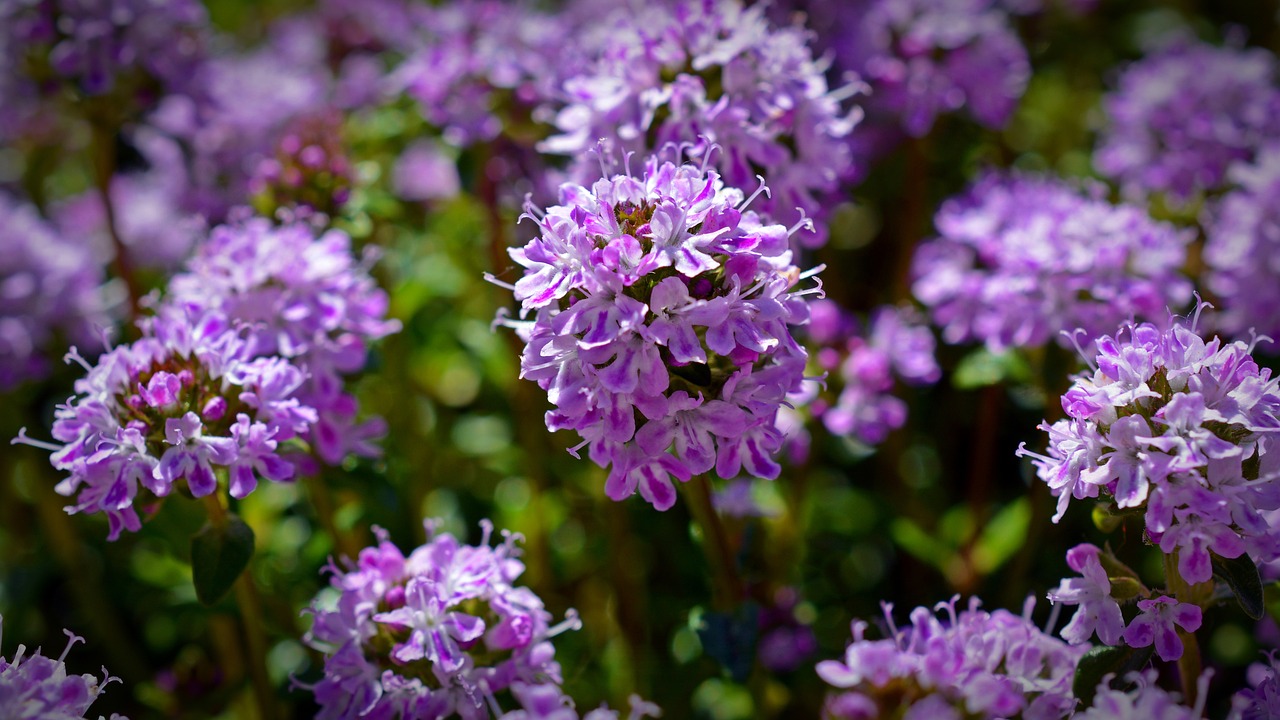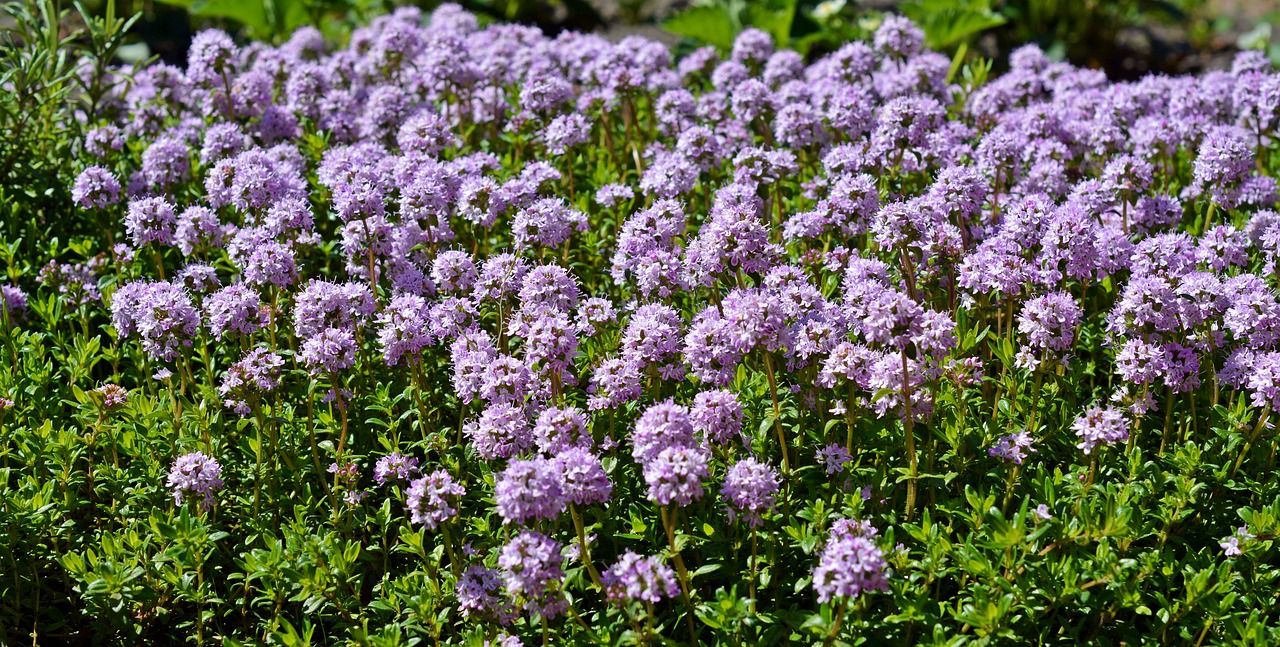IDENTIFICATION
Scientific name:
Thymus vulgaris
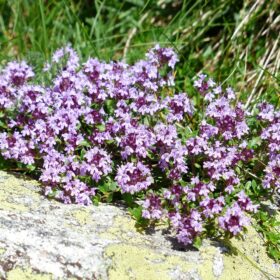
Italian common name:
Common or major thymus
Family:
Lamiaceae
Origin:
from Italy to Spain and the Atlantic coasts including Algeria.
Environment:
garrigues (the garrigue is a natural area with low and fruitful shrubs that reach a maximum of 1-1.5 metres, but are generally less than 50 cm) and arid slopes; but also the sparse prairies, meadows and arid pastures from the hilly to the mountainous plains. They are found up to 1500 m. above sea level.
Evergreen or deciduous:
evergreen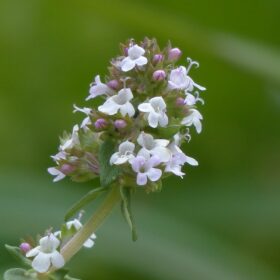
Toxicity:
not
PLANT RECOGNITION
Height:
10 – 30 cm.
Width (extension):
30 cm.
Habit:
small aromatic perennial shrub
Leaf:
linear shape, but with edges that roll up into a tube downwards and outwards resulting in a needle-like shape, opposite two by two and arranged at right angles to the upper pair (decussate). Grey-green in colour, lighter on the underside due to the presence of hair.
Flower:
The flowers are small, tubular, pink-violet in colour, grouped in spicastrums (groups of flowers that emerge in the axils of opposite leaves). Light pink. The flowers are collected in whorls with a spherical to elongated shape
Flowering:
from May to July (September depending on the location)
Fruit:
The fruit is a tetrachenium. Insignificant for our purposes
Stem:
the aerial part is woody, erect, tortuous, very branchy which tends to lignify after 4, 5 years of life, brown in color with a quadrangular section.
Property:
The leaves of this plant contain proteins, carbohydrates, fiber and vitamins: A (retinol), B1 (Thiamin), B2 (Riboflavin).
In aesthetics it can be used in foot bath water to obtain an anti-fatigue and disinfectant action.
In medicine it is used to extract the active ingredient thymol used in pharmacology as a fungicide. Thyme essential oil is used against coughs and sore throats. In particular, according to folk medicine, this plant has many medicinal properties that you find here
Parfume: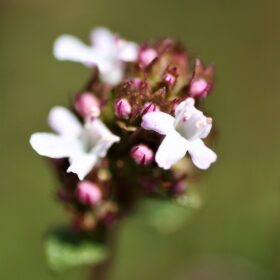
yes intense
NEED
Maintenance:
low
Light Exposure:
full sun
Soil type:
light, calcareous, draining and sunny. The preferred substrate is calcareous but also calcareous/siliceous, low nutritional values of the soil which must be arid.
Soil acidity:
pH neutral
Italian climatic area:
in Italy it is a rare species and is found in the North-West and the Center (Tyrrhenian side). In the Alps it is found mainly in the western quadrant.
Need for water: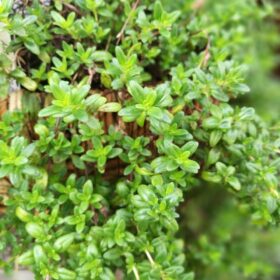
It cannot tolerate water stagnation. It is a drought resistant plant and usually does not require artificial irrigation.
Propagation:
by seed, by division of the tufts or by cutting of the lateral branches already lignified, i.e. wood-coloured in spring.
Pruning:
In spring it is best to remove dry or damaged vegetation to avoid the onset of diseases. Thyme, like rosemary and lavender, is one of those plants that does not regenerate if cut too low.
Diseases:
the most common are two rusts: Puccinia menthae and Aecidium thymi which causes reddish spots on the underside of the leaves and on the petioles.
Water stagnation, as already mentioned, causes rotting of the collar or root.
Aphids can attack young leaves.
PARTICULARITY 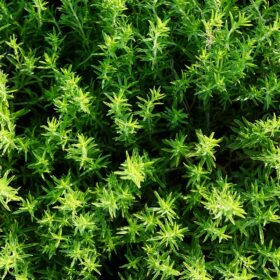
We know that multiple derivations of the name Thymus are proposed and since they are all credible, we submit them to you so that you can choose the one that best suits you.
According to one hypothesis, the word Thyme derives from the Latin “thymum-i,” which comes from the term “thymiana-atis“, which means “very fragrant“.
In another version, some link it to the Greek thymòs, in its meaning of “courage”, because the soldiers believed that its perfume promoted audacity. In ancient times, in fact, the aroma of thyme – perhaps because it was so intense and vigorous – was considered capable of instilling courage, so soldiers toned their bodies by washing it with thyme water, and reinvigorated their soul by drinking thyme herbal teas.
Furthermore, the generic name (Thymus) may be derived from an ancient Greek verb “thyein”, meaning “to have a smell” used by Theophrastus (an ancient Greek philosopher and botanist, disciple of Aristotle, author of two extensive botanical treatises), for a fragrant plant used as incense in sacrifices.
vulgaris stands for common.
In the Middle Ages, a sprig of thyme was placed under the pillow to keep nightmares away and ladies used to embroider thyme plants on the knights’ insignia as a sign of good luck.
Legends, however, say that, thanks to its scent, the Thyme flower is the favorite of fairies.
Annotations
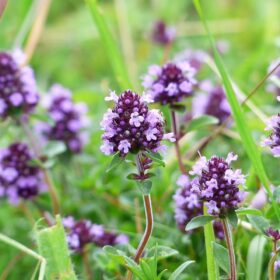
Plant suitable for the rock garden. Very slow growth.
Recognition is difficult because it is present in different shapes and with different hairiness of the stem (which you can learn more about on Wikipedia)
It is a melliferous plant, meaning that bees like it and gives excellent honey which however is rare due to the limited areas of thyme cultivated. It was considered the best honey in classical Greece.
To find out how to prepare Thyme flavored honey, read here
It adapts perfectly to the creation of splendid dense, colorful lawns that give off, especially when stepped on, an intoxicating scent of lemon, cumin or pine, i.e. the typical aroma of the variety planted.
Other important species are T. serpyllum, T. capitatus, T. albus, T. citriodorus and others.
The Priola Nurseries advise us on the preferred combinations which are with Acaena, Antennaria, Armeria, Dianthus, Helianthemum and Sempervivum. Furthermore they say that to have a good result it must be planted with a density of 6 seedlings per m2.
In the kitchen:
When dried, thyme maintains a strong and concentrated aroma. the taste is slightly sour with a recognizable herbal note. It is used at the end of cooking to flavor fish, meat, pasta, salads and pizza dishes.
THE MONDO DEL GIARDINO ADVICE
Thyme seems to be one of those plants which, due to all the positive characteristics it possesses, cannot be missing on a respectable balcony, terrace or garden in the position with the greatest possible sun!
Now on horseback! Work awaits us! Our new wonderful outdoor space is about to be born!
GOOD WORK and…if you have any questions, write to info@ilmondodelgiardino.com
Image sources: thanks to Pixabay and many thanks to Silvia for the photo for social media, Wälz for the cover photo and then to follow, Hans, Hans, lejandro Piñero Amerio, hannelorededecker, TinaKru, photosforyou, Hans and Wälz for the photo closing.


